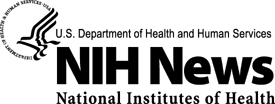Research Findings Open New Front in Fight against
AIDS Virus
Human Protein May Offer Novel Target for Blocking HIV Infection
A research group supported by the National Institutes of Health
(NIH) has uncovered a new route for attacking the human immunodeficiency
virus (HIV) that may offer a way to circumvent problems with drug
resistance. In findings published today in the online edition of
the Proceedings of the National Academy of Sciences, the researchers
report that they have blocked HIV infection in the test tube by
inactivating a human protein expressed in key immune cells.
Most of the drugs now used to fight HIV, which is the retrovirus
that causes acquired immune deficiency syndrome (AIDS), target
the virus’s own proteins. However, because HIV has a high rate
of genetic mutation, those viral targets change quickly and lead
to the emergence of drug-resistant viral strains. Doctors have
tried to outmaneuver the rapidly mutating virus by prescribing
multi-drug regimens or switching drugs. But such strategies can
increase the risk of toxic side effects, be difficult for patients
to follow and are not always successful. Recently, interest has
grown in attacking HIV on a new front by developing drugs that
target proteins of human cells, which are far less prone to mutations
than are viral proteins.
In the new study, Pamela Schwartzberg, M.D., Ph.D., a senior investigator
at the National Human Genome Research Institute (NHGRI), part of
NIH; Andrew J. Henderson, Ph.D., of Boston University; and their
colleagues found that when they interfered with a human protein
called interleukin-2-inducible T cell kinase (ITK) they inhibited
HIV infection of key human immune cells, called T cells. ITK is
a signaling protein that activates T cells as part of the body’s
healthy immune response.
"This new insight represents an important contribution to
HIV research," said NHGRI Scientific Director Eric D. Green,
M.D., Ph.D. "Finding a cellular target that can be inhibited
so as to block HIV validates a novel concept and is an exciting
model for deriving potential new HIV therapies."
When HIV enters the body, it infects T cells and takes over the
activities of these white blood cells so that the virus can replicate.
Eventually, HIV infection compromises the entire immune system
and causes AIDS. The new work shows that without active ITK protein,
HIV cannot effectively take advantage of many signaling pathways
within T cells, which in turn slows or blocks the spread of the
virus.
"We were pleased and excited to realize the outcome of our
approach," Dr. Schwartzberg said. "Suppression of the
ITK protein caused many of the pathways that HIV uses to be less
active, thereby inhibiting or slowing HIV replication."
In their laboratory experiments, the researchers used a chemical
inhibitor and a type of genetic inhibitor, called RNA interference,
to inactivate ITK in human T cells. Then, the T cells were exposed
to HIV, and the researchers studied the effects of ITK inactivation
upon various stages of HIV’s infection and replication cycle. Suppression
of ITK reduced HIV’s ability to enter T cells and have its genetic
material transcribed into new virus particles. However, ITK suppression
did not interfere significantly with T cells’ normal ability to
survive, and mice deficient in ITK were able to ward off other
types of viral infection, although antiviral responses were delayed.
"ITK turns out to be a great target to examine," said
Dr. Schwartzberg, noting that researchers had been concerned that
blocking other human proteins involved in HIV replication might
kill or otherwise impair the normal functions of T cells.
According to Dr. Schwartzberg, ITK already is being investigated
as a therapeutic target for asthma and other diseases that affect
immune response. In people with asthma, ITK is required to activate
T cells, triggering lung inflammation and production of excess
mucus.
"There are several companies who have published research
about ITK inhibitors as part of their target program," Schwartzberg
said. "We hope that others will extend our findings and that
ITK inhibitors will be pursued as HIV therapies."
NHGRI researchers received support for this work from the NIH
Intramural AIDS Targeted Antiviral Program. Chemical compounds
used in the research were synthesized at the NIH Chemical Genomics
Center, which was established through the NIH Roadmap for Medical
Research and is administered by NHGRI. The Boston University group
originally participated in the research while at Pennsylvania State
University, where they received support from Penn State Tobacco
Formula Funds, and where Dr. Henderson received support from the
National Institute of Allergy and Infectious Diseases (NIAID).
For more information about HIV/AIDS, go to: http://www3.niaid.nih.gov/healthscience/healthtopics/HIVAIDS/overview.htm.
NHGRI is one of the 27 institutes and centers at the NIH, an agency
of the Department of Health and Human Services. The NHGRI Division
of Intramural Research develops and implements technology to understand,
diagnose and treat genomic and genetic diseases. Additional information
about NHGRI can be found at its Web site, www.genome.gov.
NIAID is a component of the NIH. NIAID supports basic and applied
research to prevent, diagnose and treat infectious diseases such
as HIV/AIDS and other sexually transmitted infections, influenza,
tuberculosis, malaria and illness from potential agents of bioterrorism.
NIAID also supports research on basic immunology, transplantation
and immune-related disorders, including autoimmune diseases, asthma
and allergies. News releases, fact sheets and other NIAID-related
materials are available on the NIAID Web site at www.niaid.nih.gov.
The National Institutes of Health (NIH) — The Nation's
Medical Research Agency — includes 27 Institutes and
Centers and is a component of the U.S. Department of Health and
Human Services. It is the primary federal agency for conducting
and supporting basic, clinical and translational medical research,
and it investigates the causes, treatments, and cures for both
common and rare diseases. For more information about NIH and
its programs, visit www.nih.gov.
|

